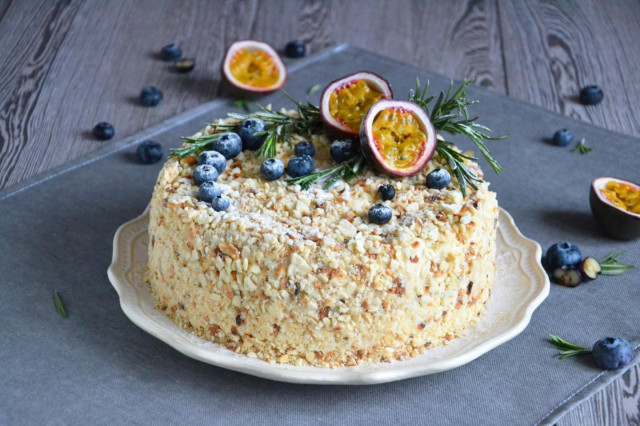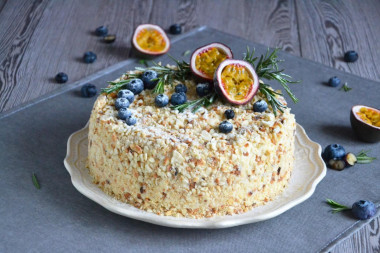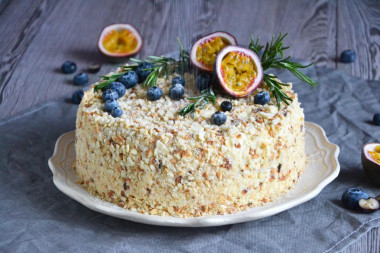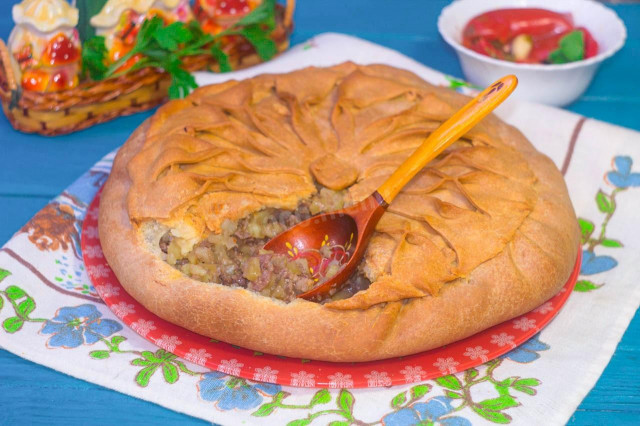Composition / ingredients
Step-by-step cooking
Step 1:
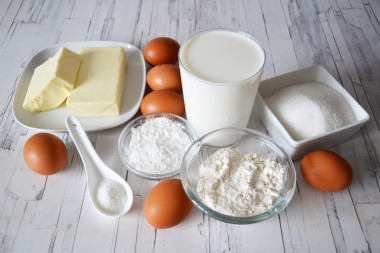
Cream. To begin with, we will prepare the cream, since it needs a lot of time to cool down to room temperature. I generally made the cream the day before, and the next day I cooked cakes and collected the cake. So, we will need: milk; butter at room temperature; eggs; sugar; flour; starch and vanilla sugar.
Step 2:

Pour 1.2 liters of milk into a saucepan and bring to a boil.
Step 3:

Grind eggs with sugar and vanilla sugar until smooth.
Step 4:
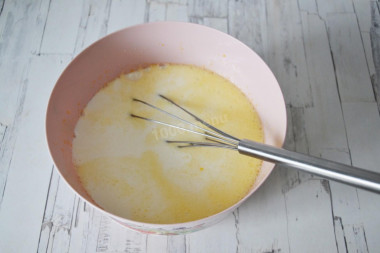
Pour the remaining 300 ml of milk into the eggs. Mix it up.
Step 5:

Add the sifted flour with starch. Mix the mixture thoroughly until smooth so that there are no lumps. At the same time, it is better to add milk to the flour, and not vice versa. I forgot about this rule and as a result I got small lumps that could not be broken with a whisk. I had to use a mixer.
Step 6:
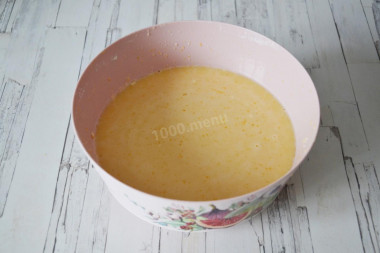
This is the mass that turned out in the end.
Step 7:
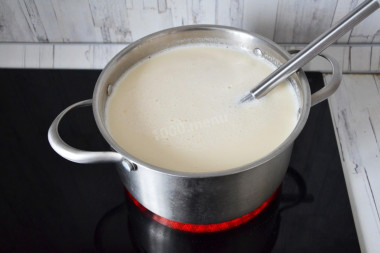
Pour the egg mixture into boiling milk in a thin stream with constant stirring.
Step 8:

Continuing to stir constantly, bring the cream to a boil over medium heat. The cream should thicken to the desired consistency. You can check by running a spoon or a spatula over the surface of the cream: the trace does not tighten.
Step 9:
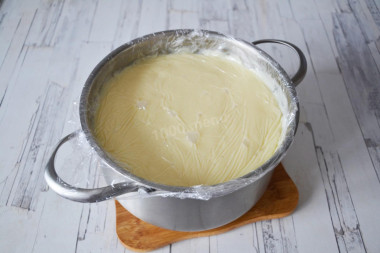
Remove the cream from the heat and cool at room temperature. To prevent a crust from forming on the cream, and it forms already in the first minutes of cooling, it is better to cover the cream with cling film in contact.
Step 10:
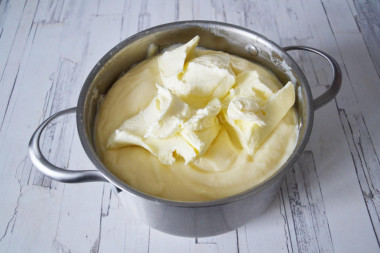
Add soft butter to the cooled custard.
Step 11:

Beat the cream with a mixer until smooth.
Step 12:
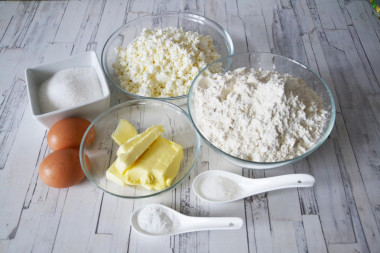
Dough. To make cottage cheese cakes, we will need: cottage cheese; flour; soft butter; eggs; sugar; vanilla sugar and baking powder.
Step 13:
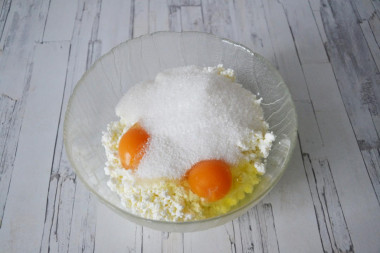
In a deep bowl, combine cottage cheese, eggs, sugar, vanilla sugar.
Step 14:
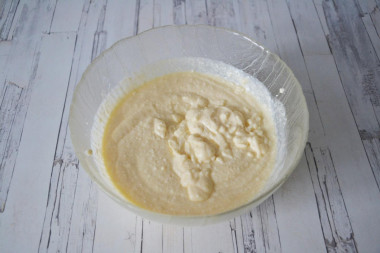
Mix. Since my cottage cheese is lumpy, I whipped the cottage cheese with a blender. So the dough will turn out more homogeneous without pieces of cottage cheese.
Step 15:

Add soft butter at room temperature. Stir so that the oil spreads over the entire mass. I kneaded the dough in the kitchen machine with a nozzle "hook".
Step 16:

Sift flour with baking powder and add to the dough.
Step 17:
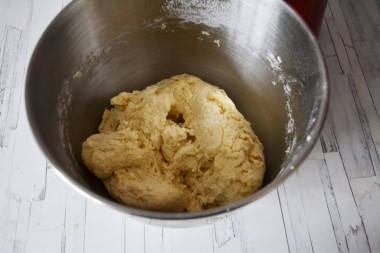
Knead a soft elastic non-sticky dough.
Step 18:
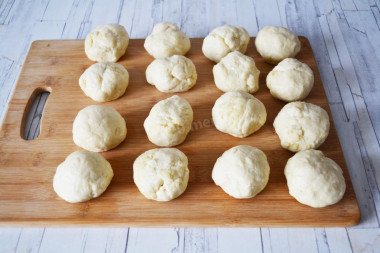
Divide the dough into 15 identical pieces and roll them into balls. Send the dough balls to the refrigerator for 30 minutes.
Step 19:
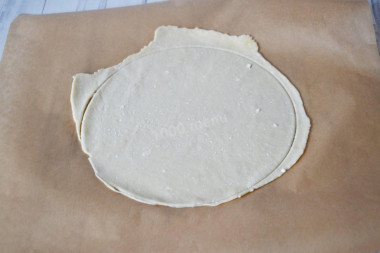
Roll out cakes from each ball on parchment paper.
Step 20:

Put a plate with a diameter of 20 cm on top and circle the cake with a knife. I did the cutting with a cooking ring of the appropriate diameter.
Step 21:

Bake the cakes in a preheated 180 ° C oven for 5-7 minutes.
Step 22:
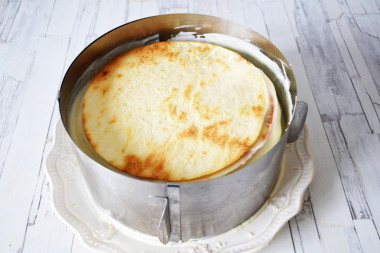
Put the cakes on top of each other, and put the trimmings from the edges in a separate bowl.
Step 23:
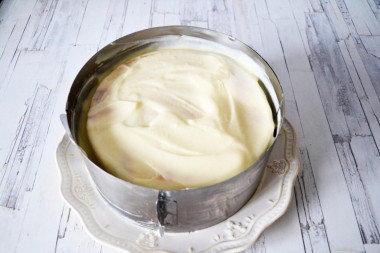
Assemble the cake by plentifully layering the cakes with cream (cottage cheese cakes absorb cream very well, so you don't need to feel sorry for it, 3-4 tablespoons of cream go for each cake, fortunately it turns out a lot) and folding on top of each other. The last cake is also liberally lubricated with cream.
Step 24:

Cut the cakes into crumbs.
Step 25:
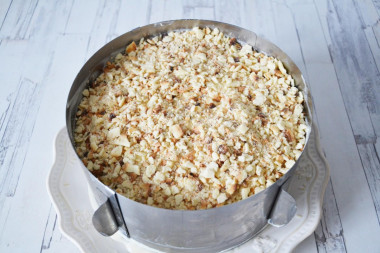
Sprinkle crumbs on top of the cake, leaving some crumbs for the sides. Tighten the mold with cling film and refrigerate for 12 hours for impregnation.
Step 26:

The next day, remove the form. Sprinkle the sides of the cake with crumbs as well.
Step 27:
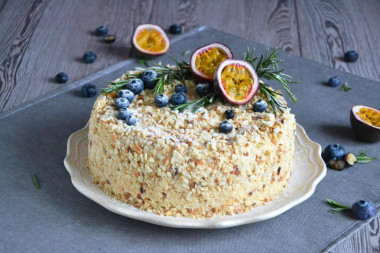
Decorate the cake as desired. I decorated it with passion fruit, rosemary and blueberries. If desired, sprinkle the cake with powdered sugar. Bon appetit!
Calorie content of the products possible in the composition of the dish
- Whole cow's milk - 68 kcal/100g
- Milk 3.5% fat content - 64 kcal/100g
- Milk 3.2% fat content - 60 kcal/100g
- Milk 1.5% fat content - 47 kcal/100g
- Concentrated milk 7.5% fat content - 140 kcal/100g
- Milk 2.5% fat content - 54 kcal/100g
- Chicken egg - 157 kcal/100g
- Egg white - 45 kcal/100g
- Egg powder - 542 kcal/100g
- Egg yolk - 352 kcal/100g
- Ostrich egg - 118 kcal/100g
- Cottage cheese of 40% fat content - 466 kcal/100g
- Cottage cheese of 20% fat content - 233 kcal/100g
- Cottage cheese of 18% fat content - 226 kcal/100g
- Cottage cheese of 10% fat content - 156 kcal/100g
- Low-fat cottage cheese - 75 kcal/100g
- Cottage cheese with sour cream - 260 kcal/100g
- Fruit curd - 147 kcal/100g
- Soft dietary cottage cheese - 170 kcal/100g
- Vitalinia cottage cheese - 64 kcal/100g
- Cottage cheese "morning" ( "danone") without sugar - 91 kcal/100g
- Cottage cheese - 156 kcal/100g
- Whole durum wheat flour fortified - 333 kcal/100g
- Whole durum wheat flour, universal - 364 kcal/100g
- Flour krupchatka - 348 kcal/100g
- Flour - 325 kcal/100g
- Granulated sugar - 398 kcal/100g
- Sugar - 398 kcal/100g
- Starch - 320 kcal/100g
- Butter 82% - 734 kcal/100g
- Amateur unsalted butter - 709 kcal/100g
- Unsalted peasant butter - 661 kcal/100g
- Peasant salted butter - 652 kcal/100g
- Melted butter - 869 kcal/100g
- Baking powder dough - 79 kcal/100g
- Vanilla sugar - 379 kcal/100g

